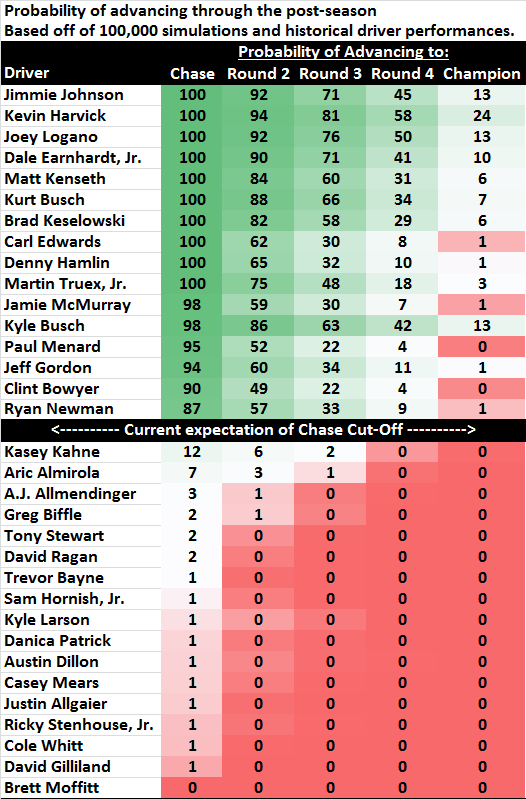For the second week in a row in NASCAR's Sprint Cup Series, the leader of the race ran out of gas, getting passed and losing on an empty tank.
This time it was Joey Logano and Kyle Busch who took advantage, finishing 1-2 at Watkins Glen in New York as Kevin Harvick ran out of gas. It was the exact opposite of the previous week, when Logano and Busch were running 1-2 at Pocono in Pennsylvania, but both ran out of gas, giving up their chance at a win.
Also for the second week in a row, title contender Kasey Kahne crashed and finished way back. His 42nd place at Watkins Glen was actually an improvement from his dead-last 43rd at Pocono.
Being last and second to last in successive weeks is not how you qualify for the Chase, NASCAR's version of the playoffs. Just two weeks ago he was sitting pretty at a 77 percent chance of making it, but with these two terrible weeks, he has dropped far—down to a measly 12 percent.

Contrast that to last week's numbers, when Kahne still had a good shot of making it back in, at 40 percent. One wreck he could handle, two is too much. Remember the Chase starts Sunday, Sept. 20.
Kahne's teammate, Jeff Gordon, didn't fare much better. Gordon finished 41st at Watkins Glen, and has seen his Chase chances slide ever so subtly to 94 percent, down from 99 percent. There are only four races to go to decide who makes it in. Sixteen drivers will make it—and everybody else will be out. Kahne's only realistic chance of getting in is by winning one of the next four races. He's been able to sneak in that way in past years, so it's more than just theoretically doable.
If not, he'll be the biggest name driver to lose out. That would be a disappointment compared to drivers like Jamie McMurray, Paul Menard, Clint Bowyer and Ryan Newman, who have generally not had the same level of career success as Kahne—yet all four of them are on track to crack the Chase despite being winless this season.
How the Chase model works
Remember the way drivers qualify for the Chase:
(1) they have to be in the top 30 in points;
(2) they have to win a race.
(3) If fewer than 16 drivers meet the first two criteria, the remaining slots are given to the remaining nonwinners who are highest in the points standings.
That's why Busch and all his wins might not make it in, because he's still 30th in points. And that's why winless Gordon will still get in, because he's high enough in the points standings.
With four races to go before the Chase, it's most likely that we will see some new winners in that time. We've had 11 different drivers win a race so far this year, and the model suggests that number will go up. Look for a winless driver (like Gordon) to get his first win of the year in the next month.
Here's our expectation for how many unique winners this season will have by the time the Chase starts:
11 unique winners: 21 percent (We're at 11 right now, so this means all repeat winners)
12 unique winners: 36 percent (So one additional new winner, with the rest being repeat winners)
13 unique winners: 26 percent
14 unique winners: 13 percent
15 unique winners: 4 percent (That means the next four races are won by four currently winless drivers)
Andrew Maness at PitRho, a racing data and analytics firm, has a model that simulates the season 100,000 times based on each driver's performance in this season and in recent years. Not surprisingly, Harvick has the highest chance of winning the title, at 24 percent. He was last year's champion and has been consistently strong all year, finishing in first or second in almost half the races, and in the top 10 in almost every race.
Disclosure: Like CNBC, NBC and the NBC Sports Network are part of NBCUniversal.



